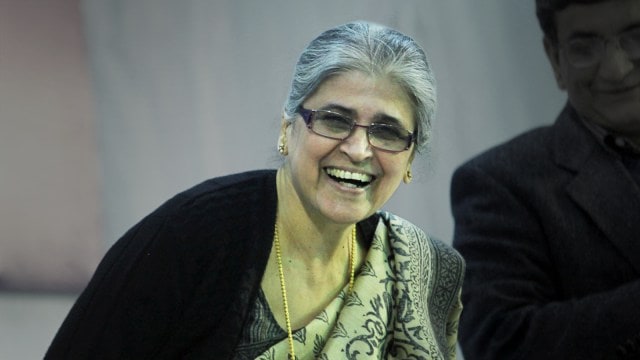Aamir Khan is Head-Legal Project, Indian Express digital and is based in New Delhi. Before joining Indianexpress.com, he worked with Press Trust of India as News Editor, editing legal stories from the Supreme Court and various High Courts. He also worked as an Associate Editor with Bar and Bench, where he led long-form storytelling, ran series on crucial and interesting legal issues, conducted exclusive interviews and wrote deep-dive stories. He has worked for the Indian Express print between 2013 and 2016, when he covered law in Mumbai and Delhi. Aamir holds an LLB degree, PG Diploma in Journalism (New Media) and a Bachelor's in Life Sciences and Chemistry. You can reach him at: aamir.khan@indianexpress.com. ... Read More
Meet new 8th Pay Commission head Justice Ranjana Prakash Desai
Justice Ranjana Prakash Desai, 8th Pay Commission head: Former Supreme Court judge Ranjana Prakash Desai will head 8th Pay Commission Panel after Union Cabinet on Tuesday approved terms of reference of the commission, which will recommend changes in the salaries and other benefits of central government employees.
 Justice Ranjana Prakash Desai to lead 8th Pay Commission Panel and expected to submit recommendations in 18 months.
Justice Ranjana Prakash Desai to lead 8th Pay Commission Panel and expected to submit recommendations in 18 months.Justice Ranjana Prakash Desai: Justice Ranjana Prakash Desai will head the Eighth Central Pay Commission after the Union Cabinet, chaired by Prime Minister Narendra Modi, on October 28 approved the terms of reference of the commission.
Justice Desai, following her retirement in 2014, has held some key nodal positions — most recently being announced as the head of a five-member panel to frame Uniform Civil Code (UCC) guidelines in Gujarat.
Who is Justice Desai?
She was born on October 30, 1949 in Mumbai and graduated in Arts from Elphinstone College in 1970 and obtained her law degree from the Government Law College, Bombay in 1973. Joined the legal profession on July 30, 1973.
She worked as a junior of Justice Pratap when he was at the bar and appeared in several civil and criminal matters. She also worked with her father S G Samant, an eminent criminal lawyer. She was appointed as Government Pleader in 1979.
Justice Desai then became a Special Public Prosecutor for preventive detention matters in 1986.
She was appointed to the post of Government Pleader, Appellate Side of the Bombay High Court on November 1, 1995 and was elevated to the bench of the Bombay High Court on April 15, 1996.
Justice Desai was elevated to the Supreme Court on September 13, 2011 and retired on October 29, 2014
Notable judgments
In 2011, a Bombay High Court bench she was heading, confirmed the death penalty to 26/11 terrorist Ajmal Kasab,terming the case as rarest of rare and holding there was “no scope of reform” of the convict.
In 2012, she comprised the bench, which reduced substantially the governments discretionary and dignitaries quota among Haj pilgrims and fixed the 2012 Haj quota at 300 seats against the governments proposed 5,050.
In 2014, she was appointed in the panel by then Chief Justice of India P Sathasivam after media reports emerged in November 2013 saying that “a recently-retired judge” had misbehaved with a law intern. The panel had submitted as report with regards to the allegations.
In the same year, a bench Justice Desai was a part of, allowed casting of “negative votes” observing the provision can be provided in existing electronic voting machines (EVMs) without any “additional cost” or change in the technology.
The Election Commission was then asked to implement the NOTA option either in a phased manner or in one go with the assistance of the Centre and directed the government to provide necessary help for implementation of its direction.
Other roles
Desai also headed the Delimitation Commission of India, whose final order for the Union Territory of Jammu and Kashmir recommended seven additional constituencies — six for Jammu and one for Kashmir — taking the total number of seats in the UT to 90 from 83 earlier. The panel’s decisions, which cleared the decks for the Assembly polls in the UT, however were met with criticism amongst mainstream parties in the Valley.
She also served as the chairperson of the Search Committee that was constituted to recommend the panel for consideration of the chairperson and members of the Lokpal. She also heads the Press Council of India.
Notably, she headed the drafting committee for the UCC in Uttarakhand, which became the first state to implement the UCC in the country, a year after the Desai-led panel submitted its report.
Apart from Justice Desai, the commission will have IIM Bangalore Professor Pulak Ghosh as Member (Part-Time), and Petroleum Secretary Pankaj Jain as Member-Secretary. It will submit its recommendations within 18 months.
The Commission, while making the recommendations, is expected to consider the following:
- The economic conditions in the country and the need for fiscal prudence.
- The need to ensure that adequate resources are available for developmental expenditure and welfare measures.
- The unfunded cost of non-contributory pension schemes.
- The likely impact of the recommendations on the finances of the State Governments which usually adopt the recommendations with some modifications.
- The prevailing emolument structure, benefits and working conditions available to employees of Central Public Sector Undertakings and private sector.



- 01
- 02
- 03
- 04
- 05





























